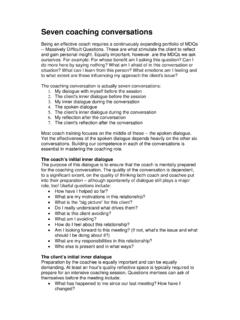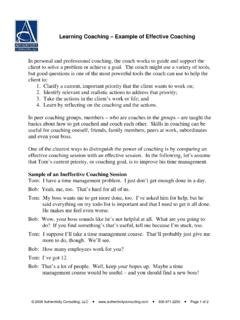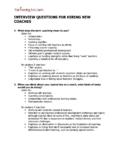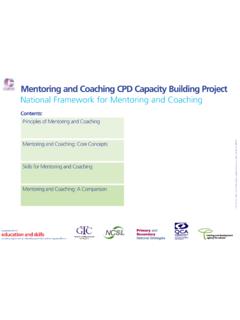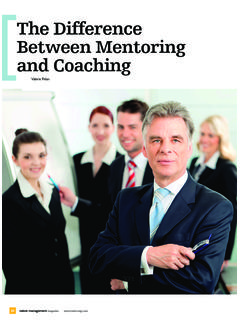Transcription of CENTER FOR QUALITY OF MANAGEMENT JOURNAL
1 A Message from the ChairPage 2 David WaldenLearning: What Does It Mean?Page 4 Thomas H. LeeA Conversation About Conversations:Page 15 Analog Devices CEO on BuildingHigh Performance Organizations Ray StataLanguage for Action:Page 21 New Concepts to AddressSoft Side MANAGEMENT Issues Gary Burchill and David WaldenUnderstanding Unclear Situations and Each OtherPage 29 Using the Language Processing Method Ted Walls and David WaldenManaging the Soft Side Special IssueVol. 4, No. 4 WINTER 1995 Copyright 1995, 1998 The CENTER for QUALITY of MANAGEMENT , Inc. Permission to make digital or hard copies of all or part of this work for personal or classroomuse is granted without fee provided that copies are not made or distributed for profit or commercial advantage and that copies bear this notice and the fullcitation on the first page.
2 To copy otherwise, to republish, to post to servers, or to redistribute to lists requires prior specific permission and/or a is by permission of The CENTER for QUALITY of MANAGEMENT , Inc. One Alewife CENTER , Suite 450 Cambridge, Massachusetts 02140 USAT elephone: (617) 873-8950 Email: The CENTER for QUALITY of MANAGEMENT Authors retain rights for re-publication of their : 1072-5296 CENTER FORQUALITY OF MANAGEMENTJOURNALR eprint No. RP06200 Improving the QUALITY of relationships and the QUALITY of conversationsis key to making our new organization, work by helping people whoare geographically separated and who don t know each other very wellwork more effectively together.
3 Also, the QUALITY of relationships andconversations is at the core of learning to work effectively in teams,which we believe will become an essential competency for competing inthe Link to TQMTo begin, I want to emphasize that this subject is not a new fad that isdifferent from or in lieu of TQM. Rather, so far in TQM we have focusedon the hard stuff to facilitate improvement work that is, the tools andmethods, like Seven Steps problem-solving, Voice of the Customer(VOC) and hoshin planning and we shall continue to do so. But asTom Malone of Milliken says, the soft stuff is actually more importantthan the hard stuff and much more difficult to master.
4 A lot of compa-nies with mature TQM programs are coming to this same conclusion,but they don t understand how to improve the soft believe it will be possible to operationalize the soft stuff if you beginto think about conversations as a process that can be continuouslyimproved by the PDCA cycle. That is, important conversations shouldbe deliberately planned to achieve their intended purpose and thenchecked after execution to determine how well the process worked andhow to improve it the next time. With a little coaching and feedback,you will be surprised by how much your conversations can beimproved and by how much what you say and how you say it affectsthe QUALITY of your relationships and the effectiveness of your manage-ment can also think about organizations and business processes as net-works of conversations that are mostly about making requests andpromises on the one hand, or offers and acceptances on the other.
5 Theperformance of a company is determined in large measure by its com-petence in making and fulfilling commitments both to internal andexternal 4 NO. 4 WINTER1995 15 Ray Stata is CEO of AnalogDevices, Inc. His interest inapplying Fernando Flores ideas to improve manage-ment practices at Analog ledto CQM s most recent studyon Conversation AboutConversationsRay Stata, CEO, Analog Devices, OFMANAGEMENTJOURNAL[Editorial comment: On February 8 and March 28-29, 1994, Ray Stata spoke toemployees of Analog Devices on the importance of conversation, trusting rela-tionships and a model for improving the way people make and keep commit-ments as key tools for a next jump in productivity.]
6 The following text was edit-ed from the transcripts of these two presentations with the intention of main-taining the informal and personal nature of Ray s presentations.]What do managers do anyway?The traditional model depicts man-agers as decision-makers. One viewof empowerment, to which I don tsubscribe, is that you only need togo to your boss when you need adecision you are not authorized tomake. Of course, making decisionsis part of the job. But in the realworld managers mostly engage inconversations, both written and spo-ken, to understand and resolve con-cerns and conflicts, to reach agree-ment on goals for action, to dealwith breakdowns a lot of this isdone through skillful listening andspeaking.
7 So we can say that themost important and universal tooland process that managers use isconversation, and the most impor-tant skill is the ability to makeintended actions occur througharticulating, eliciting and coordinat-ing for PossibilitiesIn learning the how to skills ofconversations, we need to distin-guish among several categories ofconversations. For example, thereis one type of conversation that hasto do with changing the world bywhat you think and say. This is thevision thing. In looking back at mycareer, I believe I ve had an abilityto create visions or new ideas aboutwhat I think the world shouldbecome, but in retrospect, I have toadmit that I wish I had been moreskilled at enrolling people in myviews.
8 When we were a muchsmaller company, this was not aproblem, because I had directresponsibility for work, and I couldinfluence others by what I did ver-sus what I said. But as we becamelarger, my approach to managingchange was to write memos,expecting something to happen as aresult. But, in fact, nothing wouldhappen, or if it did happen, thenonly with inordinate took me a long time to under-stand that if I wanted something tohappen that was very different andcomplex, then I had to enroll peo-ple in my views. Authority doesn twork. In the enrollment process, Ihave to present my views in such away that I remain open to accom-modating other points of is very difficult for someonelike me with strong views, but it isnecessary, not only to avoid mis-takes, but also to motivate others tojoin me with enthusiasm in chang-ing the world, or for me to joinwith ve had to shift my conversationsfor future possibilities from a modeof advocating to a mode of inquir-ing.
9 That is, I have to ask, What doyou think? versus declaring Itshall be, and then really listening tolegitimate concerns and thoughtfulalternatives. The power of team-work is that each of us sees theworld from a different the wisdom of these per-spectives is much more powerfulthan the narrow view of a singleindividual. It sounds simpleenough, but it isn t, because it goesagainst our natural instincts to caremore about what others think isimportant than what we think isimportant. If we are part of a com-munity of inquirers instead of acommunity of advocates, then wecan help each other keep our mindsopen. You might say this is a mar-ket-in versus product-out mentalitytaken down to the personal for ActionBut even achieving enrollment andalignment is not enough.
10 Visionshave to be translated into bring about the desired changes,you have to elicit commitments notonly to ends, but also commitmentsto the means of achieving them,with explicit, mutually agreed con-ditions of satisfaction. Too often, Ihave left conversations open endedwith the belief that people wouldknow what to do to meet myexpectations. But they didn t knowbecause they are not mind job of leaders is to make surethat the interpretations of theirexpectations are accurate; that is,who will do what by when, whereand how? The response to arequest for action can be yes, no,let s negotiate, or let me think, orI ll get back to you by a certaintime. But you need to have closureand precision in both the requestand the response.
